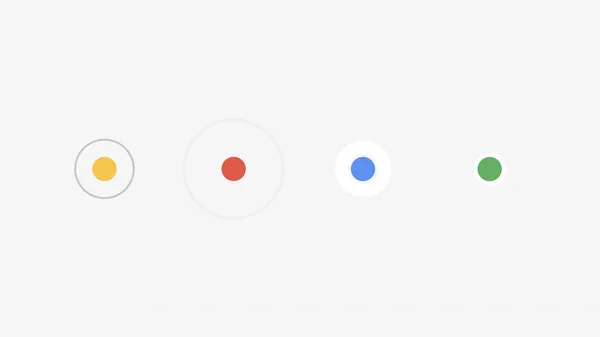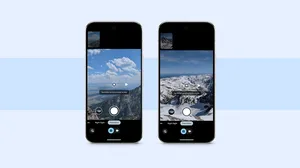Listen hear: How designers create sounds for Pixel

You know the noise your Pixel makes when you take a photo? While it may seem like a camera shutter, it’s actually the sound of a pair of scissors opening and closing, says Conor O’Sullivan, who leads Pixel’s sound design team. “It’s not just a straight recording of that action, but that’s the basis of the sound that you hear today,” he says.
When designing how your Pixel sounds, Conor and the Pixel sound design team aren’t just trying to get your attention; they’re conveying a message with sound. “Sound design is essentially the art of creating intentional sound, and doing it with context,” Conor says.
Take a look (and a listen) at how the Pixel sound design team finds inspiration, develops, tests and implements the sounds your Pixel makes.
Why we need sound design
One of the reasons sound design for devices is increasingly necessary is that our eyes are doing so much work. “There’s so much information that can fit on a smartphone screen, but we don’t want to overburden any one of the senses,” Conor says.
Sound can help communicate more information — for instance, Pixel uses different sounds to differentiate between a text and a call, or sending an email and receiving one. The sound your phone makes when it sends out an AMBER alert probably triggers some kind of adrenaline spike, but not the same way a notification about an incoming email would. “Sound is great at conveying emotion,” Conor says. “It has a positive inflection or negative inflection, or gives you a sense of urgency.”
There are different categories of sounds that designers develop for Pixel: There are gesture feedback sounds, which confirm user action in response to UI elements — for example, swiping to archive an email in Gmail. There are semantic feedback sounds, which confirm user selection and progression of action, like turning on Pixel Battery Saver. There are also attention sounds, which are sounds Pixel creates on "its own" — like an alarm. The team pays attention to form and function when designing both: The form is the more “aesthetic” side — how it makes people feel, and whether it has a playful, human sense to it. The function is what it’s supposed to do (wake someone up, tell someone a timer is complete) and how well it does that (can you hear your alarm from another room or if your phone is in your bag?).
Sound designer Harrison Zafrin worked on the sounds for Guided Frame, the Pixel camera tool that helps blind and low-vision users take selfies. It’s a great example of balancing form and function: The app combines haptics (or tactile feedback) and sound to help people guide their hand and the camera to the right position. “We came up with this system of five different zones around the viewfinder and as you get closer to the center you hear an increasingly positive musical progression, what’s called a diatonic progression. You get this sort of celebratory sound when you’re centered,” Harrison says. “I think we did a really good job using the sound and haptics to be delightful and Googly but also communicate the right information so people can get the photo.”

Another example of the importance of getting sound design right is with safety alerts like early earthquake warnings, safety check-ins or car crash detection. “Those are super tough because we’re trying to balance when to alert people with some urgency versus when to really alert them of danger,” Harrison says. The team works with researchers to understand how to accurately portray these sounds in Pixel devices.
The Pixel sound design process
“Part of the philosophy we have around creating sounds — whether it’s notifications, alarms or ringtones — is that we want them to represent Pixel really well,” says Conor. That means they think about design principles that guide how the sound team works: simple, human, playful.
Much of the process begins with, well, listening. “It’s sort of a blessing and a curse — I will be out in the world just listening to all of the sounds that people’s phones are making,” says Harrison. He describes this as intentional listening: try shutting down your other senses and just tune into what you hear. “There’s a funny video my partner took of me years ago where I’m just interacting with things in our kitchen,” Harrison says, laughing. “It’s me closing a drawer, clinking the toaster, putting rice on a pan. And I’m just listening to it all.” Oftentimes team members will record sounds from their day to day lives and share them with one another. “A field recorder is a sound designer's best friend,” Harrison says.
The team looks for input from visual designers, too. “We ask the folks who work on, say, wallpapers, ‘Hey what are you thinking for the next Pixel?’” Conor says. “And we’ll take that and see if there’s a way we can translate it to sound or use it for inspiration.” This approach has the added benefit of creating a cohesiveness to Pixel, where everything — sound, feel, look — fits together.
A particularly challenging project for Conor was working on an update to Pixel’s default ringtone. The original was called “The Big Adventure.” It’s upbeat and energetic; you’ve probably heard it before.
Your browser does not support the audio element.
A few years ago, the team wanted to redesign the ringtone to reflect the new generation of Pixel. “It became ‘Your New Adventure,’ because we wanted it to reflect all of the new customization capabilities,” Conor says. And getting it right was a long and iterative process. “It was challenging to nail the transition from this slow, gentle state to a faster, upbeat, lively tempo and sound,” he says. “We worked on that a lot.”
Your browser does not support the audio element.
Of course, once the sounds are designed and iterated on, a massive amount of testing follows. “I have probably 20 Pixel phones in my home office,” Harrison says. “I need to test everything on all the different speakers.” Beyond testing how something sounds on certain hardware, they also need to see how their sounds hold up in different situations — which presented some challenges for Harrison while working from home in 2020. “My partner and I had just moved to London into a tiny flat, and I was working on the early earthquake warning detection sound,” he says. Harrison had to test the sound — which is very loud and meant to alert you — in various circumstances; in the bathroom, in the bedroom behind a door, in a bag, in a bag outside, and so on. “I remember my partner looking at me listening to this BLEEP BLEEP BLEEP thousands of times.”
Experimenting with sound — and making it your own
New to Pixel 8 and 8 Pro is the Gems sound collection, which the team designed using AI. “Pixel 8 and Pixel 8 Pro are two of the most advanced AI-optimized devices out there, so we wanted to explore how we could use generative AI as a collaborative partner in the process for how we would create sounds and do it in a way that didn’t replace the human creative process but extend it,” Conor says. The team used in-house tools to unlock new methods and expressions while also thinking about the future of sound design. “Hopefully as people hear the Gem sounds, they get a sense of AI personality in there,” he says.
That said, Gems still very much needed a human touch. “As we were reviewing with our team, we started thinking that the sounds were a little bit too perfect, too polished,” Conor says. The team decided to go back and capture some of the “weirdness” and “quirkiness” that the tool could produce and added these elements back into the final versions.
Creativity is inherent to Pixel development, as is ultimately landing on the best possible product for users in the process. And letting users get creative is also important. Just like you can pick a wallpaper for your phone or a color scheme, you should be able to decide on sound, too. “We want people to explore and audition a range of sounds and find something that matches their identity and feels right to them,” Conor says. If you go to “Sound and vibration” settings on your Pixel, you can choose everything from how forceful a vibration is for certain actions, to installing your own sounds for ringtones.
And what if what feels right is… no sound? The team takes no offense: “Obviously, it’s an option to decide you don’t want to hear any sound at all!” Conor says. In fact, he points out, factoring in silence is even part of their sound design guidelines — certain things, like losing internet access or having low signal, don’t need sound. “Silence is just as important as haptic feedback or sound to provide a good experience,” he says. In fact, some might say it’s golden.






